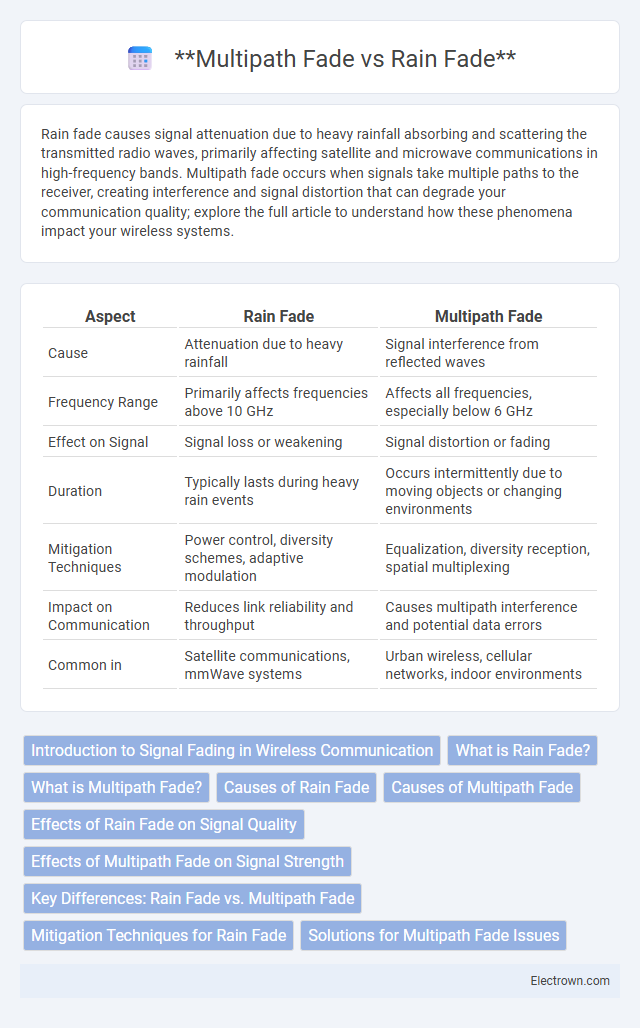Rain fade causes signal attenuation due to heavy rainfall absorbing and scattering the transmitted radio waves, primarily affecting satellite and microwave communications in high-frequency bands. Multipath fade occurs when signals take multiple paths to the receiver, creating interference and signal distortion that can degrade your communication quality; explore the full article to understand how these phenomena impact your wireless systems.
Table of Comparison
| Aspect | Rain Fade | Multipath Fade |
|---|---|---|
| Cause | Attenuation due to heavy rainfall | Signal interference from reflected waves |
| Frequency Range | Primarily affects frequencies above 10 GHz | Affects all frequencies, especially below 6 GHz |
| Effect on Signal | Signal loss or weakening | Signal distortion or fading |
| Duration | Typically lasts during heavy rain events | Occurs intermittently due to moving objects or changing environments |
| Mitigation Techniques | Power control, diversity schemes, adaptive modulation | Equalization, diversity reception, spatial multiplexing |
| Impact on Communication | Reduces link reliability and throughput | Causes multipath interference and potential data errors |
| Common in | Satellite communications, mmWave systems | Urban wireless, cellular networks, indoor environments |
Introduction to Signal Fading in Wireless Communication
Signal fading in wireless communication occurs when signal strength diminishes due to environmental factors, impacting transmission quality. Rain fade refers to signal attenuation caused by precipitation, primarily affecting higher frequency bands like Ka and Ku bands used in satellite and microwave communications. Multipath fade arises from signal reflections creating multiple propagation paths, leading to interference and fluctuations in received signal amplitude, especially in urban or indoor environments.
What is Rain Fade?
Rain fade refers to the signal attenuation caused by heavy rainfall interfering with microwave and satellite communication frequencies, primarily in the Ku and Ka bands. This atmospheric phenomenon absorbs and scatters radio waves, leading to a significant loss of signal strength and potential service interruptions. Understanding rain fade enables you to implement appropriate mitigation techniques, such as adaptive modulation or site diversity, to maintain reliable connectivity during adverse weather conditions.
What is Multipath Fade?
Multipath fade occurs when radio signals reach the receiving antenna by multiple paths caused by reflection, diffraction, or scattering from buildings, mountains, or other obstacles, resulting in signal phase shifts and interference. This phenomenon leads to fluctuations in signal strength and quality, often degrading communication performance in wireless networks and satellite links. Understanding Multipath fade is crucial for optimizing your wireless system design and improving signal reliability in challenging environments.
Causes of Rain Fade
Rain fade primarily occurs due to the absorption and scattering of microwave or satellite signals by raindrops, leading to signal attenuation and degradation. This phenomenon is especially prominent in higher frequency bands such as Ku-band and Ka-band, where the wavelength is comparable to the size of raindrops. Unlike multipath fade, which is caused by signal reflections creating interference, rain fade directly impacts signal strength by reducing signal propagation through heavy precipitation.
Causes of Multipath Fade
Multipath fade occurs when multiple reflected signal paths create interference at the receiver, often caused by obstacles like buildings, mountains, or water bodies. These reflected signals combine with the direct signal, leading to constructive or destructive interference patterns that degrade signal quality. Unlike rain fade, which results from atmospheric precipitation absorption, multipath fade primarily arises from the physical environment's impact on signal propagation.
Effects of Rain Fade on Signal Quality
Rain fade significantly degrades signal quality by causing attenuation in microwave and satellite communications, leading to increased bit error rates and reduced data throughput. This phenomenon occurs when raindrops absorb and scatter radio frequency signals, particularly at frequencies above 10 GHz, resulting in signal weakening or temporary loss. Effective mitigation techniques such as adaptive modulation and power control are crucial to maintaining reliable communication during heavy rainfall conditions.
Effects of Multipath Fade on Signal Strength
Multipath fade causes fluctuations in signal strength due to the interference of multiple signal paths arriving at the receiver with different phases, leading to constructive and destructive interference patterns. This effect results in rapid signal fading and distortion, particularly in urban environments with many reflective surfaces. Unlike rain fade, which is caused by atmospheric absorption and attenuation of the radio signals, multipath fade primarily impacts the signal quality and reliability in short-range and indoor wireless communications.
Key Differences: Rain Fade vs. Multipath Fade
Rain fade primarily affects satellite and microwave signals due to heavy precipitation causing signal absorption and scattering, resulting in attenuation and degraded communication quality. Multipath fade occurs when signals reflect off surfaces, causing multiple delayed versions of the same signal to interfere and create fluctuations in signal strength, often impacting terrestrial wireless systems. Understanding these key differences helps you optimize system design by choosing appropriate mitigation techniques for rain-induced attenuation or multipath interference.
Mitigation Techniques for Rain Fade
Rain fade significantly disrupts satellite communication by attenuating signals through heavy precipitation, requiring effective mitigation techniques such as adaptive power control, site diversity, and advanced error correction coding to maintain link reliability. Employing adaptive modulation schemes dynamically adjusts transmission rates based on real-time rain intensity, ensuring optimal throughput despite signal degradation. Your satellite system's performance improves by integrating these techniques, which counteract rain fade more efficiently than those used for multipath fade, focusing primarily on atmospheric attenuation rather than signal reflection.
Solutions for Multipath Fade Issues
Multipath fade issues can be effectively mitigated using diversity reception techniques such as spatial, frequency, and polarization diversity, which help by receiving multiple signal paths to improve signal quality. Equalization algorithms and adaptive filtering can also counteract the distortion caused by multipath interference, enhancing the reliability of wireless communication systems. Deploying smart antennas and advanced signal processing methods like MIMO further optimize multipath signal reception, reducing fade impact in environments prone to signal reflections.
Rain fade vs Multipath fade Infographic

 electrown.com
electrown.com